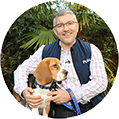Is your dog resource guarding? We take a look at what this natural – but potentially worrying – behaviour looks like, and share expert advice on how to stop a dog resource guarding food, toys and even people.
Resource guarding is a natural behaviour that occurs when an animal feels the need to keep others away from a specific item or resource. Sometimes called possessive aggression, it stems from the need of wild or feral animals to guard their limited resources in order to survive – but while it might be a useful trait for wild dogs, in pet dogs it can become problematic, and even dangerous, if left unchecked.
What does resource guarding look like in dogs?
Resource guarding can occur in any dog breed, and can present as a dog guarding one particular item or everything they view as valuable, from toys and treats to their bed or even a favourite location – or, in some cases, a particular member of their family. Even experienced dog owners can’t always anticipate what their dog might choose to guard, or how they will react to someone encroaching on their space while guarding.
Signs of a dog resource guarding include changes to their body language and defensive and aggressive behaviours, such as:
- Standing over or near a specific item
- Stiffened body
- Lowered body posture
- Raised hackles
- Growling
- Lunging
- Snapping
- Biting
How to stop a dog resource guarding
If you notice resource guarding behaviours in your dog, there’s plenty you can do to encourage them to become more relaxed around items they perceive as high value. But it’s vital to address this behaviour as soon as possible. In puppies, early training is one of the best ways to prevent resource guarding, because you can teach them they don’t need to worry about losing a specific item. The ‘drop it’ command – and the similar command ‘leave it’ – is a particularly important one for puppies and older dogs alike.
To teach a dog to ‘drop it’:
- When your dog is playing with a toy they love, offer them something they like even better. This could be a high-value food reward or another toy.
- Show your dog the new item, a little distance away from the original item. Encourage them to come over and investigate.
- Pick up the original item.
- During initial training sessions, return the original item after a minute or so. This helps your dog learn that they can share without stress.
- Repeat the above steps until your dog can reliably leave the item.
- Add the cue ‘drop it’ as you ask your dog to drop the original item, or ‘leave it’ if they’re approaching an item you don’t want them to pick up.
Good manners around food are also important. Don’t allow your dog to share your food, and treat their own food with similar respect: it’s theirs, and shouldn’t be taken off them unless it’s absolutely necessary. It’s fine, and can be helpful, to remove favourite items such as toys if they’re causing problems, with a view to potentially reintroducing them later – but this shouldn’t be done without good reason, and never as a way to punish.
In adult dogs, if resource guarding has come on suddenly it’s a good idea to schedule a vet exam, as changes in behaviour can be a sign of pain or an underlying medical condition. A qualified behaviourist can work with you to get to the root of the issue for your dog and provide tailored advice – but while you’re working on reducing their possessive behaviours, make sure your family and visitors know not to approach your dog when they’re near their preferred resource, whether that’s food, treats or a specific location.
How to stop resource guarding between dogs
If you’re a multi-pet household, you may notice your dogs resource guarding from one another, or from other pets such as cats. It’s important not to overlook this behaviour, as resource guarding can escalate – instead, take sensible steps to prevent your pets competing over food, toys or favourite spaces. Feed your animals in separate areas of the house (or if that’s not possible, at different times), from different bowls. If toys are becoming a battleground, manage access by handing them out for specific play sessions, then tidying them away. Ensure each animal has their own comfortable area to rest, with a favourite blanket or bed – and if they’re competing over a particular space, it’s best to block access unless you’re there to supervise.
Top tip: whether you’ve noticed resource guarding or not, it’s always a good idea to spend time managing your pets’ relationships with each other to prevent future conflict.
How to stop a dog from resource guarding a person
Most dogs resource guard food or toys, but occasionally this behaviour can extend to people, too. This can be misinterpreted as protectiveness towards the human – but in reality it’s no less self-motivated than guarding a favourite object, and has the potential to become dangerous if left unchecked.
A dog resource guarding a favourite human being can lead to them dominating relationships within the family, which isn’t healthy. If you’re noticing this behaviour, try to gradually reduce the amount of time your dog spends one-on-one with that person, and encourage them to spend more time with other members of the household. As with other types of resource guarding, it’s best to address this behaviour as soon as possible to prevent it becoming a habit. A clinical behaviourist will be able to advise you on the best approach to meet your dog’s specific needs.
